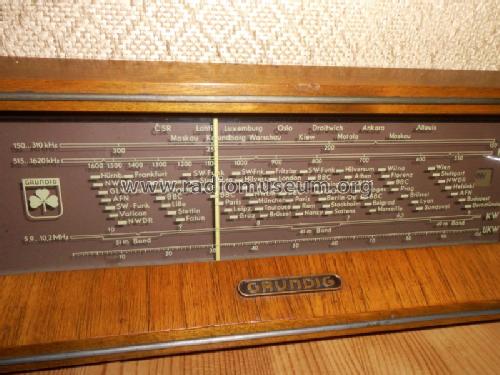Type 238W / Super 238W
Grundig (Radio-Vertrieb, RVF, Radiowerke); Fürth/Bayern
- Country
- Germany
- Manufacturer / Brand
- Grundig (Radio-Vertrieb, RVF, Radiowerke); Fürth/Bayern
- Year
- 1950/1951
- Category
- Broadcast Receiver - or past WW2 Tuner
- Radiomuseum.org ID
- 1870
-
- alternative name: Grundig Portugal || Grundig USA / Lextronix
Click on the schematic thumbnail to request the schematic as a free document.
- Number of Tubes
- 6
- Number of Transistors
- Semiconductors
- 220B60
- Main principle
- Superheterodyne (common); ZF/IF 468 kHz
- Tuned circuits
- 6 AM circuit(s)
- Wave bands
- Ready for FM, has Broadcast, Long Wave, Short wave.
- Power type and voltage
- Alternating Current supply (AC) / 110, 125, 220, 240 Volt
- Loudspeaker
- Permanent Magnet Dynamic (PDyn) Loudspeaker (moving coil) / Ø 18 cm = 7.1 inch
- Power out
- 2 W (max.)
- Material
- Wooden case
- from Radiomuseum.org
- Model: Type 238W / Super 238W - Grundig Radio-Vertrieb, RVF,
- Shape
- Tablemodel, low profile (big size).
- Dimensions (WHD)
- 505 x 335 x 235 mm / 19.9 x 13.2 x 9.3 inch
- Notes
-
Bandbreite umschaltbar: 9 kHz / 3-4 kHz
KW: 5,9 ... 10,2 MHz (51... 30 m)Siehe auch Grundig 238W/HE, ein Exportmodell mit KW-Bereich 51 ... 13 m.
- Net weight (2.2 lb = 1 kg)
- 8.6 kg / 18 lb 15.1 oz (18.943 lb)
- Price in first year of sale
- 238.00 DM
- Source of data
- Kat.d. Rundf.Gr.Handel 1950/51 / Radiokatalog Band 1, Ernst Erb
- Circuit diagram reference
- Lange Schaltungen der Funkindustrie, Buch 4
- Mentioned in
- Funk-Technik (FT) (5021)
- Literature/Schematics (1)
- - - Manufacturers Literature (Prospekt, Kleeblattserie 1951)
- Other Models
-
Here you find 6212 models, 5445 with images and 4211 with schematics for wireless sets etc. In French: TSF for Télégraphie sans fil.
All listed radios etc. from Grundig (Radio-Vertrieb, RVF, Radiowerke); Fürth/Bayern
Collections
The model is part of the collections of the following members.
Forum contributions about this model: Grundig Radio-: Type 238W / Super 238W
Threads: 1 | Posts: 6
Hallo Radiofreunde,
bei meinem Gerät ist folgende Rückwand eingebaut. Anstatt der Röhre EL41 ist eine EL42 eingebaut. Auf dem Schaltplan "Super 238 W" am Bodendeckel ist ebenfalls eine EL41 eingezeichnet.
1. Welches Gerät besitze ich?
Das Magische Auge befindet sich in der Mitte. Auf dem Typenschild am Chassis steht "59915" und darunter "Gerät 36".
2. Ist das Radio UKW tauglich oder nur vorbereitet?
In die Antennenbuchsen passen die "normalen" Antennenstecker nicht (Stiftdurchmesser zu groß). Improvisiert hatte ich keinen Empfang, über Tonabnehmer funktioniert das Radio.
Als Anfänger bin ich hier schon überfordert und freue mich über jeden Hinweis. Vielen Dank, Reiner P.

Reiner Pössnicker, 07.Mar.16



























